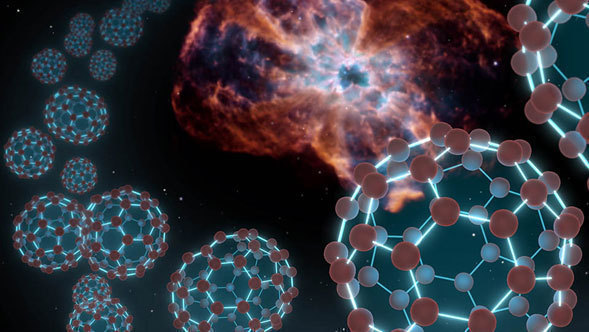For the first time ever, astronomers, with the help of NASA's Spitzer Space Telescope, discovered carbon compounds known as "Bucky balls". This family of materials includes football-shaped carbon compounds that were first discovered in the laboratory about twenty-five years ago.

"We have found what are considered to be the largest mares that exist in space," said astronomer Jan Cami of the University of Western Ontario in Canada. "We are particularly excited because these materials have unique properties that make them important participants in all types of physical and chemical processes occurring in space." The research findings were published in the scientific journal Science.
The materials consist of sixty carbon atoms arranged in a three-dimensional structure of a sphere. The alternating patterns of pentagons and hexagons match the black/white patterns found in typical football. In addition, the research team also discovered for the first time in space the more elongated form of this family, a kind of flattened football similar to a rugby ball with 70 carbon atoms. Both forms of these separates belong to a family of materials officially called fullerenes or Buckminster-fullerenes.
The research team unexpectedly discovered these moles in the planetary nebula called Tc1. Planetary nebulae are the remnants of stars, such as the Sun, shedding their outer layers of gas and dust during their "coming of age". In the center of the nebula is a hot, compact star ("white dwarf", in astronomical terminology) that illuminates and heats the clouds of material that has been detached.
The particles were located in these clouds, and this fact reflects a short phase in the star's life, in which it sheds emissions of carbon-rich materials. The astronomers used the spectroscopy device on the Spitzer Space Telescope to analyze infrared radiation emitted from the planetary nebula and identified the unique spectral signatures of these fullerenes. According to the main researcher - the telescope was aimed at the right point, at the right time. In a hundred years the fullerenes will be at a lower temperature that will be below the detection threshold of today's devices. The information obtained from the telescope was compared to the information obtained from laboratory measurements of the same isolates and the agreement between them was perfect.
"We did not prepare for this discovery," said the researcher. "However, when we noticed these clear spectral signatures, we immediately realized that we were looking at one of the most sought-after materials."
In 1970, the Japanese professor Eiji Osawa predicted the existence of fullerenes, but they were discovered in the laboratory only in 1985. The researchers simulated in the laboratory the conditions prevailing in the atmospheres of "aging" and carbon-rich giant stars in which chains of carbon were found. Surprisingly, these experiments led to obtaining large amounts of fullerenes. Since their initial discovery, the fullerenes have also been located on Earth in the soot of burning a candle, in a mantle of rocks and in meteorites ("falling stars" that have reached the Earth).
The study of fullerenes, and other materials close to them, has become a common scientific field due to the unique strength of these compounds and due to their unusual chemical and physical properties. Among other possible applications for them are innovative armor, drug delivery systems and superconducting materials.
Previous attempts to find fullerenes in space, mainly around carbon-rich stars, have failed, until now. A promising case for their presence in the thin clouds between the stars was reported about fifteen years ago, following observations of visible light radiation. The findings are still awaiting verification against laboratory information. Recently, another team using equipment on the Spitzer Space Telescope reported evidence of the existence of fullerenes in objects of a different type - but their spectral signatures were partially contaminated by other chemical substances.

3 תגובות
Galacticus, literally
What does it mean that they found out? Does it have any consequences?
When will basketballs be found in space?